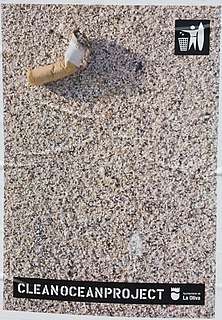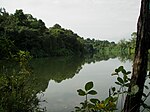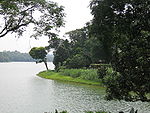
Environmental law is a collective term encompassing aspects of the law that provide protection to the environment. A related but distinct set of regulatory regimes, now strongly influenced by environmental legal principles, focus on the management of specific natural resources, such as forests, minerals, or fisheries. Other areas, such as environmental impact assessment, may not fit neatly into either category, but are nonetheless important components of environmental law.

Singapore, officially the Republic of Singapore, is a sovereign island city-state in maritime Southeast Asia. It lies about one degree of latitude north of the equator, off the southern tip of the Malay Peninsula, bordering the Straits of Malacca to the west, the Riau Islands (Indonesia) to the south, and the South China Sea to the east. The country's territory is composed of one main island, 63 satellite islands and islets, and one outlying islet, the combined area of which has increased by 25% since the country's independence as a result of extensive land reclamation projects. It has the third greatest population density in the world. With a multicultural population and recognising the need to respect cultural identities, Singapore has four official languages; English, Malay, Mandarin, and Tamil. English is the lingua franca. Multiracialism is enshrined in the constitution and continues to shape national policies in education, housing, and politics.

The United Nations Environment Programme (UNEP) is responsible for coordinating responses to environmental issues within the United Nations system. It was established by Maurice Strong, its first director, after the United Nations Conference on the Human Environment in Stockholm in June 1972. Its mandate is to provide leadership, deliver science and develop solutions on a wide range of issues, including climate change, the management of marine and terrestrial ecosystems, and green economic development. The organization also develops international environmental agreements; publishes and promotes environmental science and helps national governments achieve environmental targets.

A wetland is a distinct ecosystem that is flooded by water, either permanently or seasonally. Flooding results in oxygen-free (anoxic) processes prevailing, especially in the soils. The primary factor that distinguishes wetlands from terrestrial land forms or water bodies is the characteristic vegetation of aquatic plants, adapted to the unique anoxic hydric soils. Wetlands are considered among the most biologically diverse of all ecosystems, serving as home to a wide range of plant and animal species. Methods for assessing wetland functions, wetland ecological health, and general wetland condition have been developed for many regions of the world. These methods have contributed to wetland conservation partly by raising public awareness of the functions some wetlands provide.

Environmental protection is the practice of protecting the natural environment by individuals, organizations and governments. Its objectives are to conserve natural resources and the existing natural environment and, where possible, to repair damage and reverse trends.

Kranji Reservoir is a reservoir in the northern part of Singapore, near the Straits of Johor. It was a former freshwater river that flowed out into the sea that was dammed at its mouth to form a freshwater reservoir. It can also be classified as an estuary. The dam has a road bridging the two banks, and now prevents the sea from coming in, and is home to a marsh. The former Kranji River has three main tributaries - Sungei Peng Siang, Sungei Kangkar and Sungei Tengah.

The Singapore Green Plan 2030 is a whole-of-nation movement to advance Singapore's national agenda on sustainable development. Spearheaded by five ministries, the Green Plan charts ambitious and concrete targets over 10 years, strengthening Singapore's commitments under the UN's 2030 Sustainable Development Agenda and the Paris Agreement. Through the Green Plan, Singapore aims to achieve its long-term net zero emissions aspiration as soon as viable.

The Marina Barrage is a dam in Singapore built at the confluence of five rivers, across the Marina Channel between Marina East and Marina South. First conceptualised in 1987 by the late Lee Kuan Yew, the Barrage started construction on 22 March 2005, and was officially opened on 31 October 2008 as Singapore's fifteenth reservoir. It provides water storage, flood control and recreation. It won a Superior Achievement Award from the American Academy of Environmental Engineers in 2009.
Water supply and sanitation in Singapore is characterised by a number of challenging environments that have been achieved in a relatively small country with geographical limitations. Despite these challengess, access to water in Singapore is considered universal, affordable, efficient and of high quality.

The Thomson River, a perennial river of the West Gippsland catchment, is located in the Gippsland region of the Australian state of Victoria.

Environmental issues in Indonesia are associated with the country's high population density and rapid industrialisation, and they are often given a lower priority due to high poverty levels, and an under-resourced governance.
The Philippines' evident risk to natural disasters is due to its location. Being a country that lies in the Pacific Ring of Fire, it is prone to earthquakes and volcanic eruptions. In addition, the country is surrounded by large bodies of water and facing the Pacific Ocean where 60% of the world's typhoons are made. One of the most devastating typhoons that hit the Philippines in 2013 was Typhoon Haiyan, or "Yolanda," that killed over 10,000 people and destroyed over a trillion pesos worth of properties and damage to various sectors. Other environmental problems that the country is facing include pollution, illegal mining and logging, deforestation, dynamite fishing, landslides, coastal erosion, wildlife extinction, global warming and climate change.
The Public Utilities Board (PUB) is a statutory board under the Ministry of Sustainability and the Environment of the Government of Singapore responsible for ensuring a sustainable and efficient water supply in Singapore.

Natural resource management (NRM) is the management of natural resources such as land, water, soil, plants and animals, with a particular focus on how management affects the quality of life for both present and future generations (stewardship).natural resource management
The Regional Forum on Environment and Health in Southeast and East Asian Countries is a global framework for action provided by Agenda 21 of the 1992 United Nations Conference on Environment and Development; the Johannesburg Plan of Implementation of 2002 World Summit on Sustainable Development; the Millennium Development Goals of the United Nations and the recommendations of the fifth Ministerial Conference on Environment and Development in Asia and the Pacific on enhancing the environmental sustainability of economic growth. The second Ministerial Regional Forum was held 14–16 July 2010 in Jeju Province, South Korea. The forum is held every three years; the first was in Bangkok in August 2007.

Water resource policy, sometimes called water resource management or water management, encompasses the policy-making processes and legislation that affect the collection, preparation, use, disposal, and protection of water resources. Water is necessary for all forms of life as well as industries on which humans are reliant, like technology development and agriculture. This global need for clean water access necessitates water resource policy to determine the means of supplying and protecting water resources. Water resource policy varies by region and is dependent on water availability or scarcity, the condition of aquatic systems, and regional needs for water. Since water basins do not align with national borders, water resource policy is also determined by international agreements, also known as hydropolitics. Water quality protection also falls under the umbrella of water resource policy; laws protecting the chemistry, biology, and ecology of aquatic systems by reducing and eliminating pollution, regulating its usage, and improving the quality are considered water resource policy. When developing water resource policies, many different stakeholders, environmental variables, and considerations have to be taken to ensure the health of people and ecosystems are maintained or improved. Finally, ocean zoning, coastal, and environmental resource management are also encompassed by water resource management, like in the instance of offshore wind land leasing.
This page includes books about Singapore.

International Center for Biosaline Agriculture (ICBA) is an international, not-for-profit applied agricultural research center with a unique focus on marginal environments. It identifies, tests and introduces resource-efficient, climate-smart crops and technologies that are best suited to different regions affected by salinity, water scarcity and drought. Through its work, ICBA aims to improve food security, nutrition and livelihoods of resource-poor farming communities around the world.
Xenelaphis hexagonotus, also known as the Malaysianbrown snake, is a species of snake found across Southeast Asia. It reaches up to 2 m in length. The top of its body is dark brown, with short black bars along its sides of the front part of the body, and it is white on its belly.

Argiope versicolor, the multi-coloured Saint Andrew's cross spider, is a species of orb-weaver spider found mostly in Southeast Asia, from China to Indonesia (Java).


























